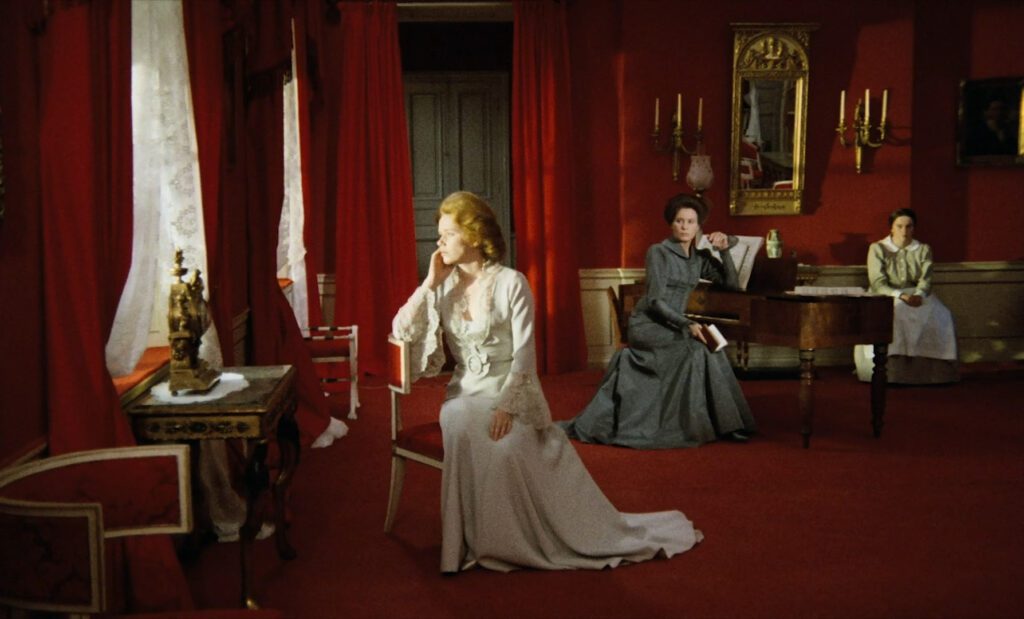
Cries and Whispers
1972, directed by Ingmar Bergman
About a quarter hour into Cries and Whispers, during a flashback as Agnes recalls watching her mother one autumn day from her childhood, there’s a dissolve to her face hiding behind a curtain. For a split second, as the two shots overlap, a single large eye appears on the little girl’s forehead, positioned exactly like the “third eye” of enlightened consciousness in Eastern religions. It’s probably not accidental that this immediately precedes the insight that justifies the whole movie. Agnes puts her hand on her mother’s cheek, and now, looking back, she remembers that “for that moment we were very close.” The idea that holding onto a single moment would forever bridge a distant relationship ties this scene to the ending, also set in autumn, where Agnes describes a single moment of contentment with her sisters and Anna on the garden swing – a moment that suffices to make her grateful for life in spite of all its pain and disappointments.
The pain we witness in Cries and Whispers is severe, and the disappointments almost as bad, but if we watch properly the ending should redeem everything, assuring us that life is worth living in spite of its brevity and its hardships. The way Bergman prepares this ending is not unique, and its resemblance to Wild Strawberries indicates that he was aware of what he was doing. Both films begin with the frightful linearity of clock time and conclude with a hopeful vision of eternity. Near the start of Wild Strawberries, Professor Borg has a nightmare about his own death foreshadowed by the omen of a clock with no hands. He feels his time is running out, but the experiences and reminiscences of the following day, as he drives across Sweden to receive his accolade, prepare him for the epiphany where he stands as an old man facing his young parents as if transcending time – a feeling of eternal closeness similar to Agnes’s two fleeting moments of intimacy with her mother and sisters.
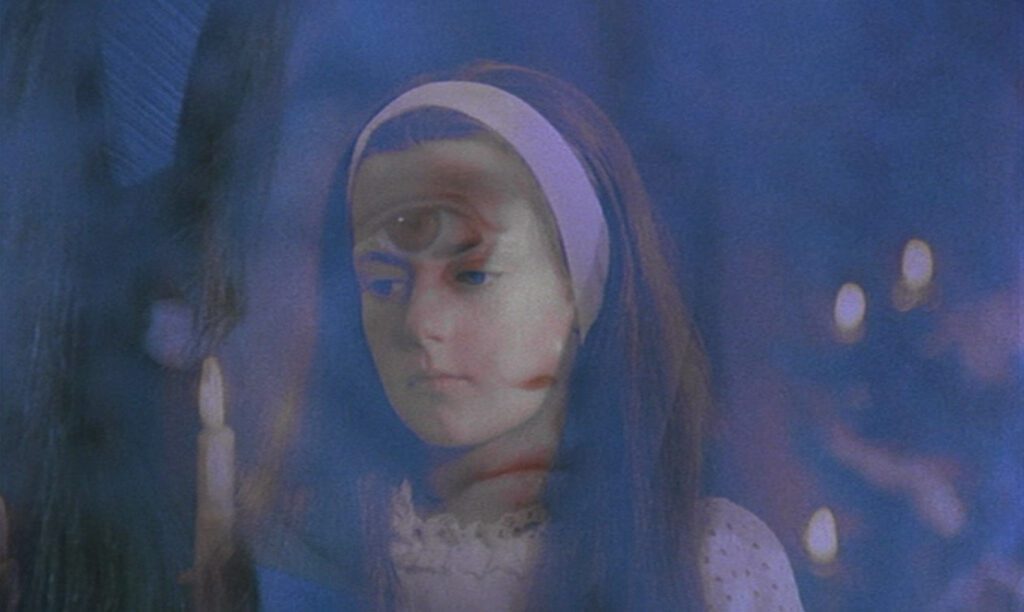
A similar structure unites many great films. Ugestu monogatari begins and ends with camera movements in the same location, a horizontal pan that starts a linear narrative, and a rising shot at the end signifying eternity. Casablanca opens with a spinning globe, a symbol of days passing, as refugees wait in limbo for their escape to the free world; but the story concludes with an immortal expression of eternal time in Rick’s line to Ilsa, “We’ll always have Paris.” The memory of Paris will sustain the couple for life just as Agnes’s moment on the swing validates her whole life and helps her to face death.
Just as Casablanca is filled with allusions to time like the famous song “As Time Goes By”, Cries and Whispers too is dominated by time – the tedium of waiting for death, painful recollections from past years, and a montage of chiming and ticking clocks that opens the action and echoes throughout the movie. The first thing Agnes does when she gets up is set her clock, and the movie’s first words, written in her diary, “It’s early Monday morning, and I am in pain,” take care to set the time even before expressing the urgency of her suffering. The movie’s insistent sense of passing time forms a necessary contrast to the timelessness of its ending where Agnes feels the completeness of her life.
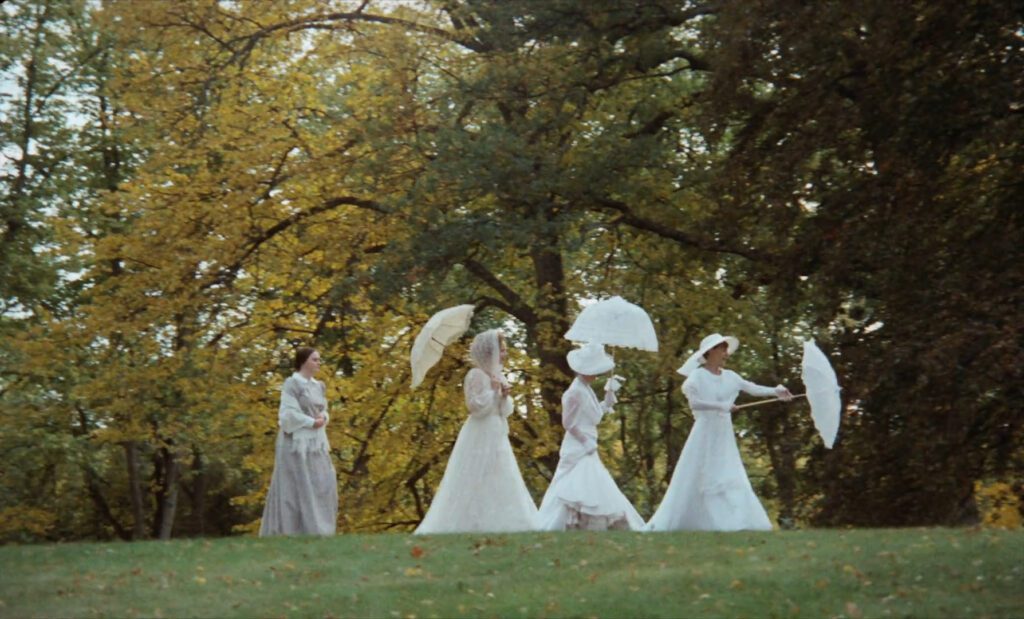
Ingmar Bergman was already interested in how we confront death when a Crusader knight tried to hold off the Grim Reaper in The Seventh Seal in 1957. Bergman must have been aware that The Seventh Seal evades its own key question – it says we can find meaning by making babies and continuing the cycle of life, which of course only passes our pain and fear of death onto our children. In Cries and Whispers Bergman returns to the same topic, bringing the wisdom of fifteen years of serious thought. It looks at death directly, replacing The Seventh Seal‘s romantic medieval iconography with Agnes’s painful expiration, and the eternal vision of its ending offers a more honest and helpful answer to the problem of mortality.
The first image in Cries and Whispers is a statue of Orpheus in the manor’s garden. The mythical Greek poet who rescued his wife from the underworld is a sign of art’s power to mediate between life and death, as Cries and Whispers will attempt to do. Neither science nor religion can help the characters; the doctor cannot delay Agnes’s death or alleviate her anguish, and the minister offers only sympathy and empty ritual. When he says of Agnes, “Her faith was stronger than mine,” it’s funny because it’s so obviously true. Anyone whose prayer rests on so many conditions: “If you meet God, and if he turns toward you, and if you know the language to make him understand, and if you’re allowed to speak to him…,” is hardly a beacon of faith. When the minister goes on to say, “Pray for those of us left behind on this dark and miserable earth beneath a cruel and empty sky,” he shows he has not learned the lesson of Winter Light. As long as religion fetishizes suffering, it will not help its followers through life. The arts, however, can step in to play this role.
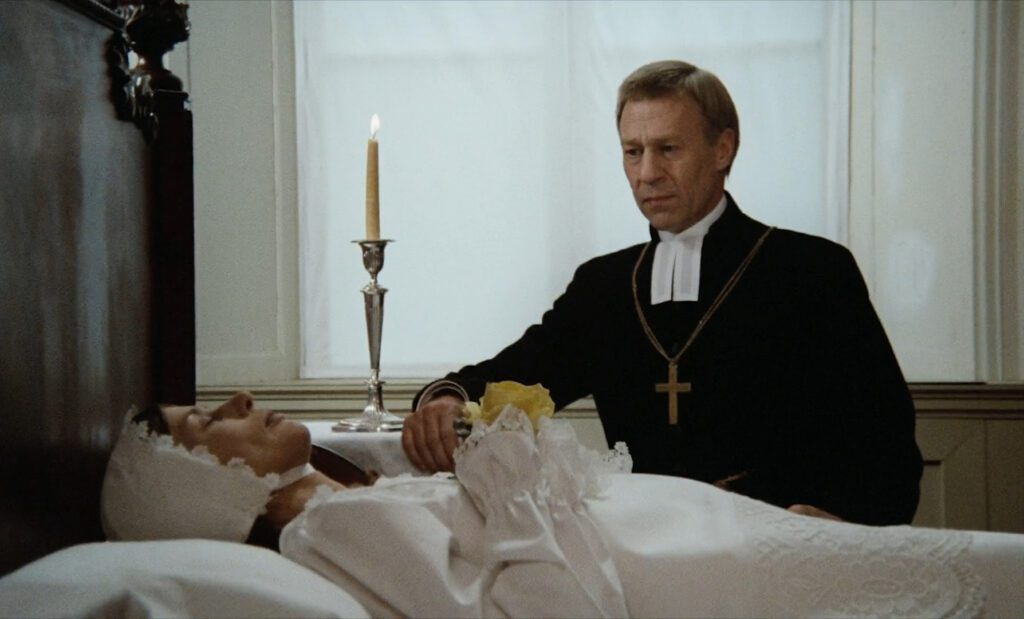
Agnes’s death is the center of the movie – both literally, as it occurs halfway through, 45 minutes in, and dramatically, as the story revolves around her death. Like a triptych, or like the three crosses on Calvary, her death is flanked symmetrically by her sisters’ flashbacks, each of which ends in blood: Maria’s memory concludes with her husband’s suicide attempt at the half-hour mark, and Karin’s with her self-inflicted vaginal wound at the hour mark. Agnes’s “resurrection” in a quasi-dream passage near the end, and a shot of Anna holding her in a Pietà pose, both flag her as a parallel to Christ. The final scene, however, tells us that we have more to learn from Agnes’s joy than from her suffering. If Christianity were to focus its lesson on Christ’s joy instead of his crucifixion, its effect would be very different.
Cries and Whispers frequently leaves Agnes aside to focus on her sisters and Anna. The alternation between them, not only in their respective flashbacks but also as they take turns visiting the resurrected Agnes, indicates an intended comparison. If we take Agnes’s two sisters and Anna as a trio, they fit the “primary colors” of human character defined in The Wizard of Oz: Maria is a coward, always shrinking away whenever things get too serious; Karin, brimming with hatred, lacks a heart; and Anna, though it would be unfair to say she lacks a brain, is a simple servant, the least educated of the three. Through these three characters Cries and Whispers shows us both the obstacles and the necessary conditions to finding meaning in life.
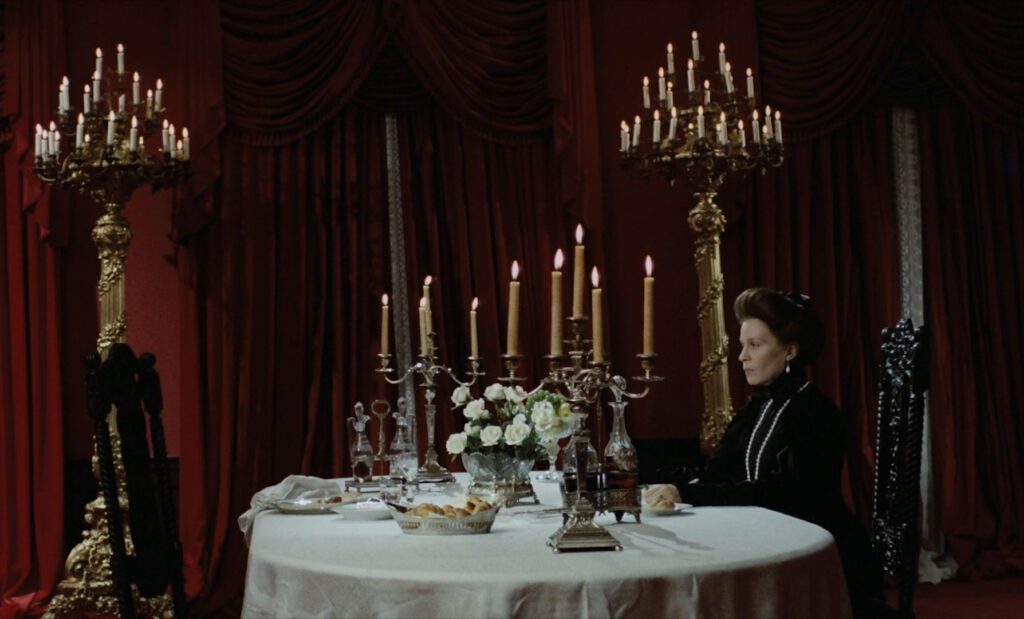
Maria and Karin form two poles of resistance to the timeless satisfaction Agnes finds in that moment of intimacy with her sisters on the swing. Both sisters are likable when relaxed, their faults only appearing during extremes of intimacy or duress. Maria is the warmer character – she expresses love naturally, succumbs to the doctor’s advances, shows concern for her husband, reaches out to Karin, and embraces the resurrected Agnes after Karin refuses to. Her cowardice, however, limits her love; she recoils from her husband when he needs her most, she flees in terror from her dead sister’s grasp, she spoils her rapprochement with Karin when she’s anxious to get back to her husband, and she soothes her conscience by handing Anna an insultingly low bonus. Karin, on the other hand, is hungry to receive love, but her contempt and disgust prevent her from giving love to her husband, from sharing Maria’s affection, and from approaching Agnes’s dead body. Neither sister shows a capacity for the unrestrained love that makes Agnes’s life-defining moments of happiness possible.
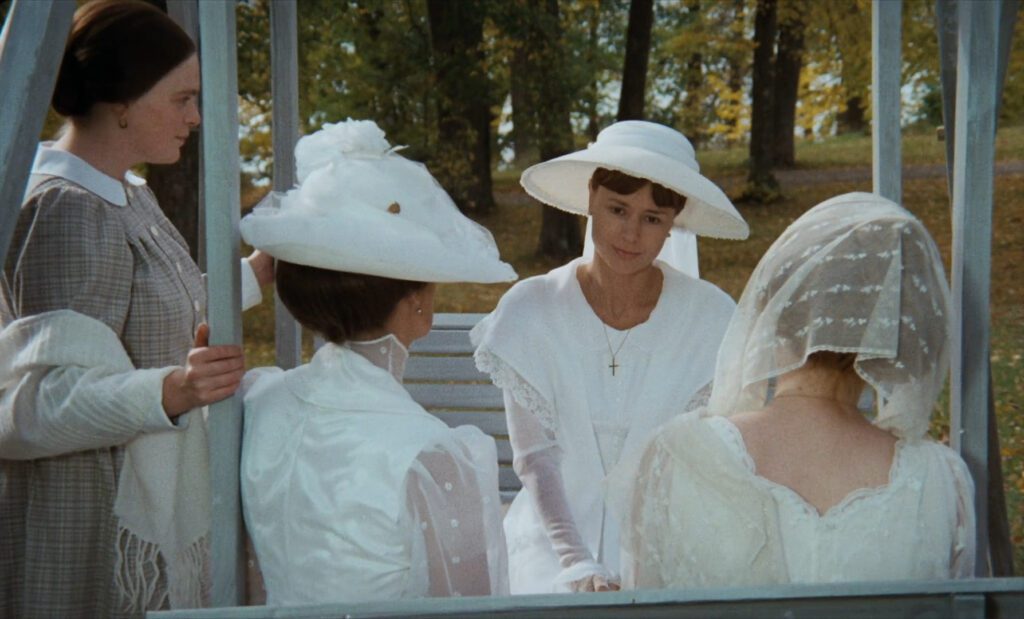
The movie sides with Anna, who cares for Agnes with a devotion that surpasses Maria’s love and Karin’s strength. The family treats her unjustly, denying her kindness and generosity when they terminate her, but the movie compensates by giving her what the two sisters lack. Though Anna had refused a keepsake from Agnes, once she’s alone we find she has a keepsake no one can take away. It’s through her eyes, after all, that the all-important moment on the wooden swing is revealed to us. Anna takes out Agnes’s diary in the same spot where she had so reverently prayed for her dead daughter, lighting a candle as she had done then, to read with rapt appreciation. She surely understands what Agnes learned when pressing her mother’s cheek, that moments of love and wonder are eternal treasures that anchor our lives and withstand the passage of time.
CONNECTIONS:
The Wizard of Oz – Woman accompanied by three characters who lack education, heart, and courage
Casablanca – Numerous allusions to time; life sustained by a memory that has become eternal
Ugetsu monogatari – Begins with linear time, ends with a vision of eternal time
A Man Escaped – Answer to the problem of how to face death
The Seventh Seal – Romantic version of death vs. reality of death
Wild Strawberries – Clocks at beginning; ends with a treasured moment of warmth and intimacy that represents eternal time
La notte – Letter or diary entry at end describing a vision of eternity
Winter Light – Minister of weak faith who represents a religion obsessed with suffering
Stalker – Characters who parallel trio from The Wizard of Oz; Scarecrow’s counterpart rewarded at end
Women on the Verge of a Nervous Breakdown – Series of clocks at the beginning gives way to a less oppressive view of time at the end
The Cook the Thief His Wife and Her Lover – Large red room that evokes an idea of blood
In the Mood for Love – Key moments at the three half-hour marks; vivid colors; abundance of clocks